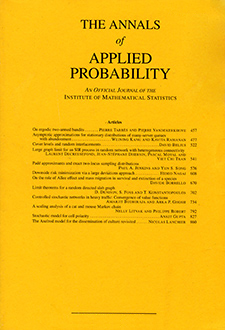Abstract
Let $\{X_\nu: \nu \in \mathbb{Z}^d\}$ be i.i.d. positive random variables with $E\{X^d_0(\log^+ X_0)^{d+\varepsilon}\} < \infty$ for some $\varepsilon > 0$ and $d \geq 2$. Define $M_n$ and $N_n$ by \begin{align*} M_n &= \max\big\{\sum_{\nu \in \pi} X_\nu: \pi \text{a self-avoiding path of length}\quad n \\ \text{starting at the origin}\big\},\\ N_n &= \max\big\{\sum_{\nu\in \xi} X_\nu:\xi \quad\text{a lattice animal of size} \quad n \text{containing the origin}\big\}.\end{align*} Then it has been shown that there exist $M < \infty$ and $N < \infty$ such that $\frac{M_n}{n} \rightarrow M \quad\text{and}\quad \frac{N_n}{n} \rightarrow N \text{a.s. and in}\quad L^1$. In this paper we show that $M = N$ if and only if $X_0$ has bounded support and $P\{x_0 = R\} \geq p_c$, where $R$ is the right end point of support of $X_0$ and $p_c$ is the critical probability for site percolation on $\mathbb{Z}^d$.
Citation
Sungchul Lee. "An Inequality for Greedy Lattice Animals." Ann. Appl. Probab. 3 (4) 1170 - 1188, November, 1993. https://doi.org/10.1214/aoap/1177005278
Information





